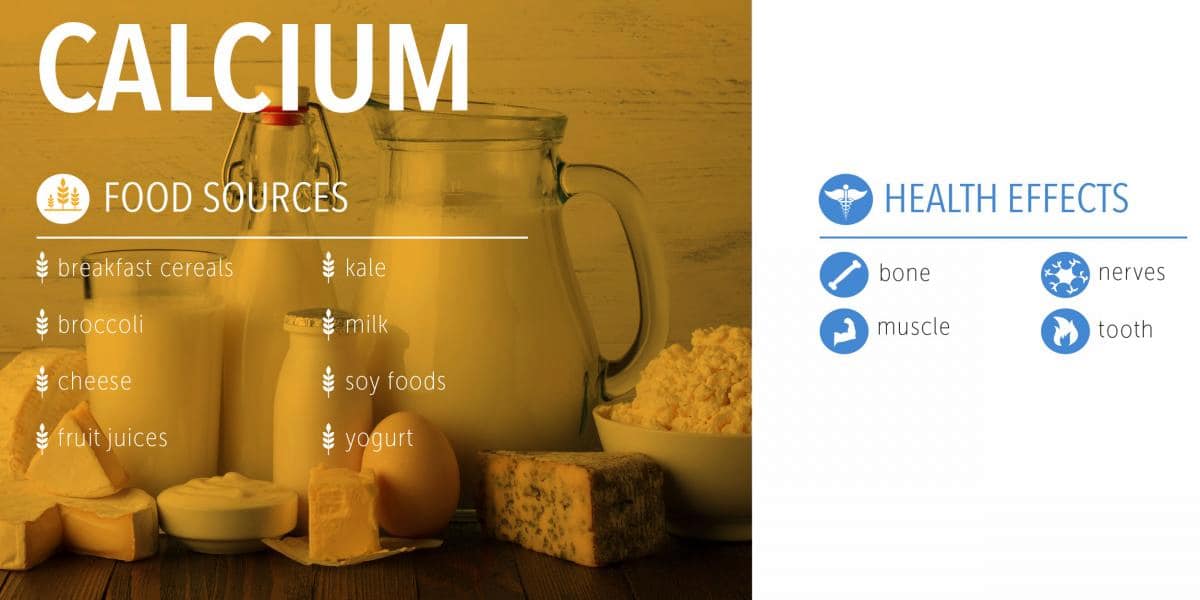You have probably heard that calcium plays a key role in keeping your bones strong. But did you know that in order to maximize your calcium absorption and function you also need vitamin D? Yup, it’s true!
Most of the calcium you eat in food is in its inactive form and needs to be converted to an active form for calcium to actually do its “thang.” That’s where vitamin D comes in. Vitamin D helps convert calcium into its active form. While vitamin D is the most common name of this particular vitamin, it can also be listed as calcifediol, cholecalciferol, ergocalciferol, vitamin D2, and vitamin D3. Regardless if it’s ergocalciferol or calcifediol, it’s still vitamin D.
Do these micronutrients have any other health benefits?
In addition to playing key roles in bone health, vitamin D has been shown to support a healthy digestive system, as well as to promote basic metabolic functions in the body. Calcium also has other health benefits beyond supporting bone health. An important mineral for oral health, calcium promotes tooth and gum health. Additionally, calcium is key for proper nerve signaling and muscle function.
How much calcium should I aim for, and what foods should I focus on?
Foods rich in calcium can be found in vegetables such as broccoli and kale; fortified foods such as breakfast cereals, juices, and soy foods; and dairy foods such as cheese, milk, and yogurt. To help you better understand how much calcium you should be getting and how much of it is in certain foods, see the tables below.
Calcium recommendations (based on age and/or lifestyle) | mg/day |
|---|---|
Source: Food and Nutrition Board, Institute of Medicine, National Academy of Sciences, 2010. | |
Infants 0 to 6 months | 200 |
Infants 6 to 12 months | 260 |
1 to 3 years old | 700 |
4 to 8 years old | 1,000 |
9 to 13 years old | 1,300 |
14 to 18 years old | 1,300 |
19 to 30 years old | 1,000 |
31 to 50 years old | 1,000 |
51- to 70-year-old males | 1,000 |
51- to 70-year-old females | 1,200 |
70 years old | 1,200 |
14 to 18 years old, pregnant/lactating | 1,300 |
19 to 50 years old, pregnant/lactating | 1,000 |
Selected Calcium-Rich Foods | |
|---|---|
Food | Calcium (mg) |
Source: The 2004 Surgeon General’s Report on Bone Health and Osteoporosis: What It Means to You. U.S. Department of Health and Human Services, Office of the Surgeon General, 2004, pages 12–13. | |
Fortified oatmeal, 1 packet | 350 |
Cheddar cheese, 1½ oz. shredded | 306 |
Milk, nonfat, 1 cup | 302 |
Yogurt, plain, low-fat, 1 cup | 300 |
Soybeans, cooked, 1 cup | 261 |
Tofu, firm, with calcium, ½ cup | 204 |
Orange juice, fortified with calcium, 6 oz. | 200–260 (varies) |
Ready-to-eat cereal, fortified with calcium, 1 cup | 100–1,000 (varies) |
Fortified waffles, 2 | 100 |
Broccoli, raw, 1 cup | 90 |
Soy or rice milk, fortified with calcium, 1 cup | 80–500 (varies) |
How much vitamin D should I aim for, and what foods should I focus on?
Foods rich in vitamin D include animal-based and fortified foods. Eggs, fatty fish, and some fish liver oils are good sources of vitamin D. Additionally breakfast cereals, margarine, milk, milk-alternative products, and some fruit juices are examples of foods that have been fortified with vitamin D. To help you better understand how much vitamin D you should be getting and how much of it is in certain foods, see the tables below.
Recommended Dietary Allowances (RDAs) for Vitamin D Source: Food and Nutrition Board, Institute of Medicine, National Academy of Sciences, 2010. | ||||
|---|---|---|---|---|
Age | Male | Female | Pregnancy | Lactation |
0–12 months* | 400 IU | 400 IU |
|
|
1–13 years | 600 IU | 600 IU |
|
|
14–18 years | 600 IU | 600 IU | 600 IU | 600 IU |
19–50 years | 600 IU | 600 IU | 600 IU | 600 IU |
51–70 years | 600 IU | 600 IU |
|
|
>70 years | 800 IU | 800 IU |
|
|
Selected Vitamin D-Rich Foods U.S. Department of Agriculture, Agricultural Research Service. 2011. USDA National Nutrient Database for Standard Reference, Release 24. Nutrient Data Laboratory Home Page | |
|---|---|
Food | IUs per serving* |
Cod liver oil, 1 tablespoon | 1,360 |
Swordfish, cooked, 3 ounces | 566 |
Salmon (sockeye), cooked, 3 ounces | 447 |
Tuna fish, canned in water, drained, 3 ounces | 154 |
Orange juice fortified with vitamin D, 1 cup (check product labels, as amount of added vitamin D varies) | 137 |
Milk, nonfat, reduced fat, and whole, vitamin D-fortified, 1 cup | 115-124 |
Yogurt, fortified with 20% of the DV for vitamin D, 6 ounces (more heavily fortified yogurts provide more of the DV) | 80 |
Margarine, fortified, 1 tablespoon | 60 |
Sardines, canned in oil, drained, 2 sardines | 46 |
Liver, beef, cooked, 3 ounces | 42 |
Ready-to-eat cereal, fortified with 10% of the DV for vitamin D, 0.75-1 cup (more heavily fortified cereals might provide more of the DV) | 40 |
Cheese, Swiss, 1 ounce | 6 |
* IUs = International Units
Having more information about the importance of these micronutrients will be key for me moving forward, since I am a woman and osteoporosis, a condition where bones become weaker and more brittle, runs in my family.
One thing I am most grateful for? My love of dairy! And now I have yet another reason to make sure I get at least a serving or two of yogurt, milk, cheese, cottage cheese, and why not add in some ice cream, every once in a while!


